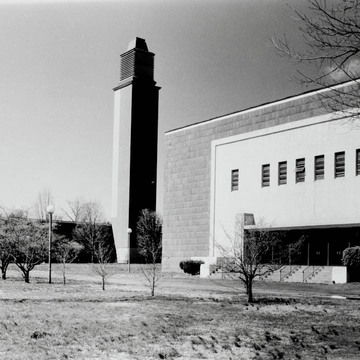From humble beginnings in a former slave jail in Richmond's Shockoe Bottom, Virginia Union University, formed by the merger of the Richmond Theological Society and the Wayland Seminary in the 1890s, has grown to occupy a sixty-five-acre site. Fueled by the efforts of northern philanthropists interested in providing an education for freed blacks, the school began an ambitious building campaign in 1897 that resulted in an outstanding collection of late Victorian collegiate architecture.
Their simultaneous construction between 1897 and 1901 and the use of identical rockfaced gray ashlar granite gave the Virginia Union buildings a consistent appearance, now blurred by later architecture. The designer of the original lecture hall, dormitory, dining hall, library, chapel, and residences for college officials was John H. Coxhead, a New Jersey native, who later designed hospitals and barracks for the army and air force between the world wars.
Rising above this urban campus is the carillon of the most extraordinary structure of the Virginia Union buildings: the library (1939, Victor Bourgeois, Leo Stijenen, and Henry Van de Velde; 1941, reconstruction, Hugo van Kuyck), which was built as the Belgian Pavilion for the 1939 New York World's Fair. Bourgeois and Stijenen designed the structure under the direction of Henry Van de Velde, an important early proponent of modernism and an early figure in the German Werkbund. The steel-frame building, designed on a U-shaped plan, was clad with brick, tiles, slate, and glass. It had elements of the International Style but with far more texture than is typical. The pavilion was originally intended to be moved to a university in Belgium after the fair, but this reuse was prevented by the outbreak of war in Europe. Instead, it was dismantled in New York and reassembled in Richmond (in a somewhat modified configuration) under the supervision of Hugo van Kuyck. The fabric of the building is symbolic of areas of Belgium: red tiles from Flanders, glass from Wallonia, and black slate from the Ardennes. Bas-relief panels by O. Jespers, H. Puvrez, and A. Dupagnes depicting culture and trade with the Belgian Congo and the international trade of Belgium serve as the principal decoration of this modernist structure.
The addition of the L. Douglas Wilder Library and Learning Resources Center (1994–1997, Livas Group) marks the return to the gabled and gray stone block flavor of the original Victorian structures at Virginia Union if not their elegance or significance. They are postmodern in style with large gable roofs, the stone only a thin veneer over a steel structural cage.

